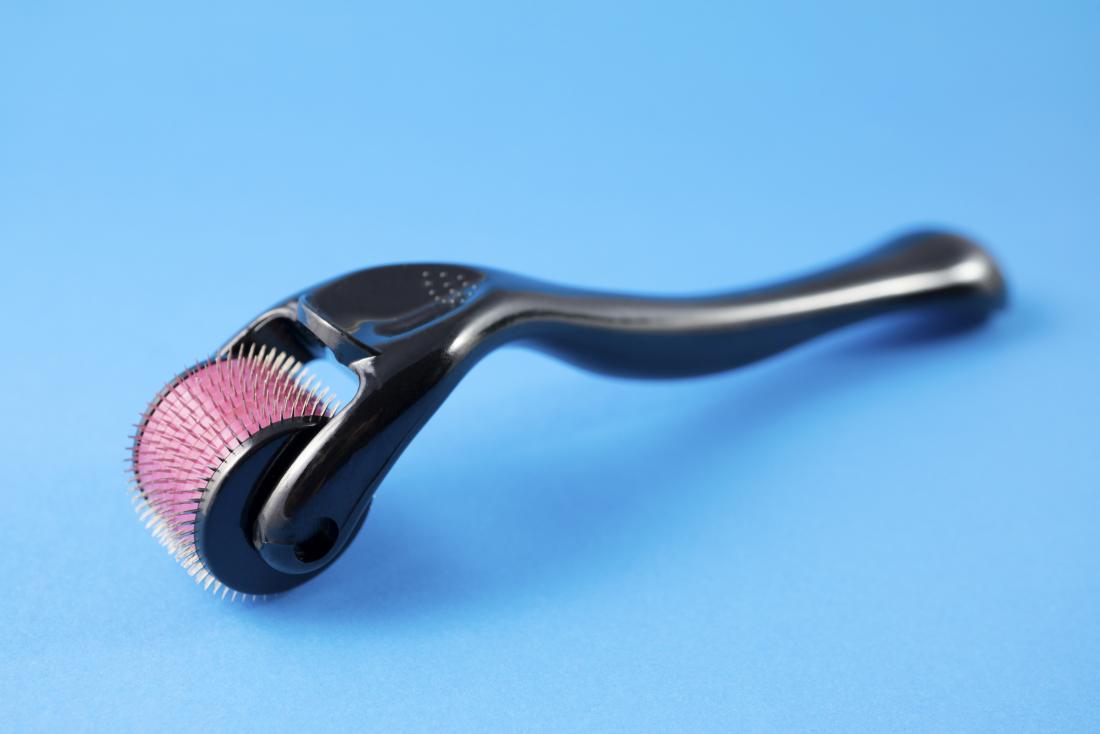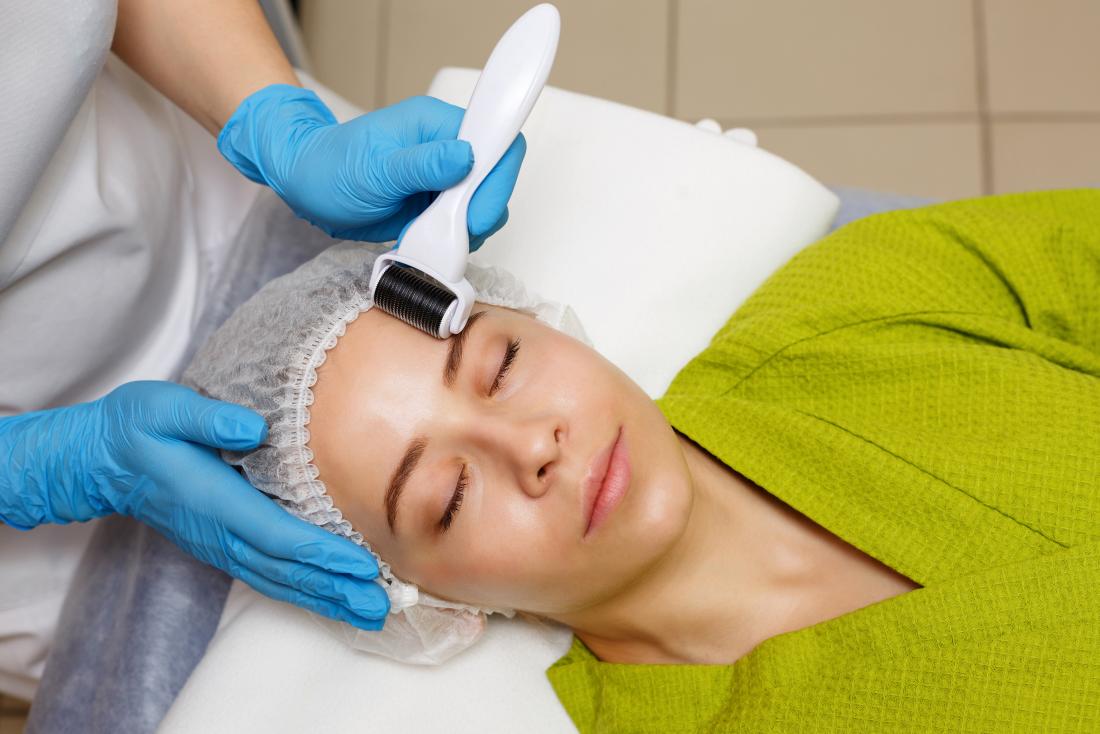Dermarollers, also known as microneedling devices, work by creating tiny punctures or microchannels in the skin. These punctures are created by a roller covered with very fine needles that are typically 0.5 to 2 millimeters in length.When the needles penetrate the skin, they create controlled injury that triggers the skin’s natural healing response. This response includes increased collagen and elastin production, improved blood flow, and the release of growth factors that stimulate skin cell renewal.Over time, this increased collagen and elastin production can lead to a number of benefits, such as improved skin texture, reduced wrinkles and fine lines, and a more even skin tone. Microneedling may also be used to help improve the appearance of scars and stretch marks.
It’s important to note that dermarollers should only be used by trained professionals or under the guidance of a healthcare provider. Improper use or misuse of a dermaroller can lead to skin damage, infection, or other complications.
A dermaroller is a skin care device used to help rejuvenate the skin, treat acne scarring, and reduce signs of aging. But how does dermarolling work? Dermarolling or microneedling is a process that was originally carried out by a dermatologist. Nowadays, it is also commonly done at home with little training. It has gained popularity in recent years as an accessible, effective, and relatively non-invasive skin treatment.
This article explores how dermarollers work and how to use one. It also offers tips for getting the best results.
What is a Dermaroller?

A dermaroller is a handheld device that is used for a skincare technique called microneedling. It typically consists of a handle and a roller with hundreds of tiny needles, usually ranging from 0.5 to 2 millimeters in length.
When the dermaroller is rolled over the skin, the tiny needles puncture the skin’s surface, creating microscopic wounds. These wounds stimulate the body’s natural healing process, which involves the production of collagen and elastin to repair and rejuvenate the skin.
Dermarollers are commonly used to improve the appearance of fine lines, wrinkles, acne scars, and stretch marks. They can also be used to enhance the effectiveness of topical skincare products by creating microchannels in the skin, allowing for better absorption of active ingredients.
It’s important to note that dermarollers should only be used by trained professionals or under the guidance of a healthcare provider, as improper use or misuse can lead to skin damage or infection.
As this 2009 review explains, dermarollers were invented through a series of discoveries. Two independent studies in the 1990s explored the use of needles to treat scar tissue. But it was not until 2005 that the first study reported the use of a dermaroller.
There are a number of different brands of dermaroller available, and they are considered to be relatively inexpensive.
It is important to purchase one from a trusted retailer and to make sure that it is sterile before it is used.
How it works?
When the dermaroller is rolled over the skin, the small, fine needles on the roller puncture the skin.
The holes that the needles create in the skin are tiny and considered to be superficial. For this reason, the treatment is not seen as invasive.
When the skin is punctured, this creates a controlled skin injury. It does not cause actual damage to the outer layer of skin. The needles help to break down any scar tissue.
As this 2016 study of the technique explains, the controlled injuries to the skin lead to superficial bleeding. This triggers the body’s wound healing response, and the following occurs:
- the skin releases substances that stimulate growth
- new blood vessels form in the skin
- the skin starts to make more collagen
Over the next 5 days, the collagen produced by the body is deposited in the area of treated skin. This helps the skin to become firmer and may reduce the appearance of fine wrinkles.
Research has found that skin treated with four microneedling sessions, 1 month apart, could lead to a 400 percent increase in collagen.
Uses of a Dermaroller

Dermarolling was originally used by dermatologists as a way of boosting collagen production for treating facial scars and skin rejuvenation.
It is now also used as a way to deliver therapeutic drugs and vaccines through the skin.
In addition, it has gained popularity as a home treatment to improve the appearance of the skin. Many people use it to try to combat the signs of aging, such as:
- loss of skin firmness
- appearance of fine lines
- start of wrinkles
Some people also use it to try to reduce pore size or reduce the production of an oil called sebum if their skin is oily. Others try dermarollers to try to improve the appearance of stretch marks.
How to use one
If using a dermaroller at home, a person should follow the steps described here:
- remove the dermaroller from its container
- spray it with alcohol solution and wash with warm water to sterilize
- prepare the skin for treatment with an antiseptic or saline wash
- hold the skin taughtroll over each section, once up and down, once side to side, and once diagonally
- bathe the skin with saline after the skin has reddened
- spray the dermaroller with alcohol solution and wash with warm water to sterilize
- leave the dermaroller to dry
- put back in the storage case
When using the dermaroller on the face, a person should treat five sections of the face in turn. These sections are:
- top right of forehead and cheek
- top left of forehead and cheek
- right under eye and lower cheek
- left under eye and lower cheek
- around the mouth
After using the dermaroller, a person can apply serums or moisturizers to their skin. The treatment is often used as a delivery system to maximize the effects of these lotions.
It is thought that these applications are absorbed much more easily and deeply by skin treated by a dermaroller than untreated skin.
People should avoid a dermaroller if they have a history of blood-clotting problems, or are using accutane or other medical treatments.
Dermarollers should not be used on areas of skin that have eczema, sunburn, or cold sores. Anywhere there are moles, skin inflammation, or rosacea should also be avoided.
Tips and best practices
Trying the following tips and best practices may help to improve a person’s dermarolling results:
- take vitamin A and C supplements in the month before treatment to boost collagen production
- use ice packs after treatment if experiencing any pain
- apply skin serums or anti-aging moisturizers after treatment
- use sunscreen in the days after use, as skin could burn more easily than usual
- repeat treatment two or three times a week
- keep away from area immediately around the eyes
- avoid use around areas of infected acne
- never share the device with another person
Things to consider when selecting a Dermaroller

As dermarolling involves needles that pierce the skin, using equipment that is not well made is a health risk.
When selecting a dermaroller online or in the store, it is essential to buy from a trusted retailer.
There are different medical dermarollers available for other uses by dermatologists. These have varying needle lengths. These devices are not available to the public, however, and may be dangerous to use a home.
Home care dermarollers have a needle length of less than 0.15 millimeters.
The following products offer a similar sort of treatment to dermarollers:
- dermastamps
- dermapens
- dermafracs
Takeaway
Dermarolling is also known as microneedling. Home dermarollers are very similar to the ones that dermatologists use but have slightly smaller needles.
Using a dermaroller at home may be a safe, simple, and cheap treatment for:
- acne scarring
- stretch marks
- large pores
- oily skin
- fine lines
- wrinkles
- loss of skin firmness
Although dermarolling can be done at home, it is a good idea to speak with a dermatologist or doctor about any ongoing skin concerns.
If a person wants to try dermarolling, they should purchase a dermaroller from a trusted retailer.

